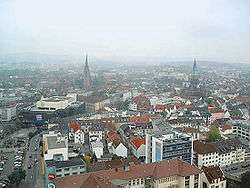Latest News for: Kaiserslautern
Edit
From battling Barcelona to Germany's third division: Kaiserslautern's downfall a story of overextension and mismanagement
The National 04 Jan 2025
The only other team from one of football’s five major leagues was German champions Kaiserslautern, based in the smallest city to host Bundesliga football that season.
Edit
There’s nothing like home for Raiders
Stars and Stripes 14 Dec 2024
KAISERSLAUTERN, Germany – The Kaiserslautern basketball teams have enjoyed home cooking to start the season, not having to leave the Kaiserslautern Military Community once before Christmas.
Edit
Kaiserslautern beats Karlsruhe 3-1 to move up to second place
Stars and Stripes 07 Dec 2024
FC Kaiserslautern beat southwest Germany rival Karlsruher SC 3-1 Saturday afternoon, for its third win in a row ... Both coaches substituted a number of players midway through the half, with Kaiserslautern’s Markus Anfang having the luckier hand.
Edit
American woman charged in fatal Kaiserslautern train station stabbing
Stars and Stripes 03 Dec 2024
The Kaiserslautern prosecutor’s office has charged a 20-year-old American woman with ... The youth chamber of the Kaiserslautern regional court will now decide whether or not to bring the case to trial.
Edit
Tex-Mex at Solecito in old town Kaiserslautern gains a lot with ‘secret’ salsa
Stars and Stripes 21 Nov 2024
Solecito Tex Mex is a recent addition to Kaiserslautern's Old Town ... The veggie tacos, a burrito with salsa roja and the spicy salsa verde at Solecito Tex-Mex in Kaiserslautern ... Steinstrasse 23, Kaiserslautern, Germany.
Edit
Stuttgart’s not ready to give up title just yet
Stars and Stripes 25 Oct 2024
25, 2024, at Kaiserslautern High School in Kaiserslautern, Germany ... 25, 2024, at Kaiserslautern High School in Kaiserslautern, Germany ... 25, 2024, at Kaiserslautern High School in Kaiserslautern, Germany.
Edit
Some new faces out to defend old titles for Kaiserslautern
Stars and Stripes 24 Oct 2024
The Kaiserslautern Raiders girls tennis team had to shuffle its lineup heading into the season ... The Kaiserslautern pair enters the tournament, which concludes Saturday, as the top seed ... Jace Martin (Kaiserslautern), 3.
Edit
‘I love working with kids’: Kaiserslautern teacher named tops in DOD schools
Stars and Stripes 22 Oct 2024
KAISERSLAUTERN, Germany — Susan Harris-Boring rarely stays in one place when teaching sixth graders language arts at Kaiserslautern Middle School ... 1, 2024, at Kaiserslautern Middle School in Germany.
Edit
Kaiserslautern, home to US troops, bans cannabis use near city hall and mall
Stars and Stripes 04 Oct 2024
A new law will ban most weekday cannabis use in Kaiserslautern’s center for the next year, the city said in a statement ... Kaiserslautern is the largest city in an area that includes Ramstein Air Base, several Army posts, and tens of thousands of U.S ... .
Edit
Hundreds in US military community rally for hospitalized Kaiserslautern High School football player
Stars and Stripes 29 Sep 2024
KAISERSLAUTERN, ... Nearly 400 stickers with “#73 STRONG,” the jersey number for Kaiserslautern High School sophomore football player Aiden Hall, were handed out during a prayer vigil on Sunday, Sept.
Edit
Kaiserslautern’s defense stymies Wiesbaden
Stars and Stripes 21 Sep 2024
Kaiserslautern’s secondary turned into receivers during the Raiders’ 46-21 victory over Wiesbaden on Friday night ... Kim and Stephenson recorded pick sixes of 35 and 25 yards, respectively ... Not that the Kaiserslautern offense was to be outdone ... 27 ... .
Edit
FUCHS And E-Lyte Open The First German Production Plant For Electrolyte Solutions In Kaiserslautern (News ...
MENA FN 16 Sep 2024
(MENAFN - EQS Group). EQS-News. FUCHS SE / Key word(s). Alliance. FUCHS and E-Lyte open the first German production plant for electrolyte solutions in Kaiserslautern (news with ... .
- 1
- 2
- Next page »



